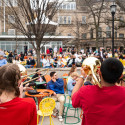Bluebirds and birdies coexist at UW golf course
With some forethought and routine maintenance, bluebirds and birdies can find common ground on Wisconsin’s golf courses. The proof is nesting on a “bluebird trail” at UW–Madison’s University Ridge golf course.
The key to success in bluebird real estate? Location, location, location, according to Gary Gaard, a turfgrass diagnostician at the College of Agricultural and Life Sciences.
|
A “bluebird trail” at University Ridge golfcourse provides nesting boxes for up to 42 pairs of Eastern bluebirds – a species whose population has suffered over the last 50 years partially because of a lack of good nesting sites. Twelve pairs nested on the course in 1998 and this year’s brood looks to be another good one. |
|
See also: North American Bluebird Society |
Gaard established the bluebird trail in 1997 at University Ridge, a 225-acre, 18-hole public golf course just outside Madison. Part of the course is wooded (not bluebird habitat) and part is built on farmland with remnants of field, fencerows and woodlot edges – ideal for bluebirds.
In 1997, only one bluebird pair nested in the 42 nest boxes placed in late May of that year at the golf course. The boxes were placed randomly on posts and trees, with little regard for bluebirds’ habitat preferences.
Gaard overhauled the nest box program in 1998, adapting it to the guidelines of bluebird re-establishment societies. The results: 12 bluebird nests in 1998. The 1999 nesting season, now underway, looks to be another good one, according to Gaard.
He started by shortening the deep nest boxes to the Herman Olson design, which made them less attractive to tree swallows. The boxes were put out earlier and moved to better bluebird habitat. They were placed at least 300 feet apart, and away from wren habitat, such as dense brush. The boxes were placed near trees that provided perches for hunting adults, and they faced cover that hid the young birds when they left the nest. Additional guidelines for golf-course placement came from University Ridge course superintendent Jeff Parks: “Don’t drive a post through an irrigation line, and we are not going to mow around a bird house.”
All the houses were mounted on steel stakes, and snakes that climbed the stakes claimed two nests in 1998. Current boxes have plastic pipe sleeves over their posts to discourage snakes, raccoons and other crawling nest raiders.
Most boxes were placed within a few yards of cart paths, to simplify maintenance and monitoring and maximize the chances of golfers seeing bluebirds. Gaard kept the boxes away from greens and tees, which comprise 5 percent of the area of a golf course but receive 90 percent of the pesticides.
“There is an anecdotal view that bluebirds exist only in the purest environments, and that they are more susceptible to pesticide bioaccumulation than other wildlife. At the Ridge, most observed bluebird insect feeding was in the no-pesticide roughs, and occasionally on fairways when insects ventured in from the rough,” Gaard notes. “Swallows that feed on insects disturbed by mowers should be better indicators of bioaccumulation.”
To ensure full houses along a bluebird trail, place cleaned-out boxes by March 15, when adult male bluebirds return to Wisconsin and stake out their territories. Remove early season nests after the residents fledge, to encourage a second nest in the same nest box. Gaard suggests keeping a few spare houses to install in newly mowed areas, or where tree swallows take over a box after an early season bluebird nest fledges.
In southern Wisconsin, the first brood of bluebird young will fledge around the end of April. The adult pair, with the assistance of the first brood, will often nest again and raise a second brood. Younger adults nest later in the year and raise one brood. Wrens and tree swallows compete for nest sites at this time, and these more aggressive species may evict bluebirds. (Other native birds using the boxes at University Ridge included tree swallows, wrens, and occasionally chickadees.)
As a turfgrass diagnostician at the College’s O. J. Noer Turfgrass Research & Education Facility, Gaard regularly visits golf courses to discuss management strategies with the superintendents. The O.J. Noer facility, which adjoins University Ridge, joined the Audubon Cooperative Sanctuary Program for Businesses in 1995. The program provides information and guidance to golf-course managers and property owners to help them preserve and enhance wildlife habitat. (For more information, contact Audubon International, Inc., 46 Rarick Road, Selkirk NY 12158; phone (518) 767-9051.)
Gaard also worked with the North American Bluebird Society, 14593 State Highway 23, Darlington WI 53530-9503; and the Bluebird Restoration Association of Wisconsin, PO Box 207, Phillips WI 54555-0207.
Tags: research




